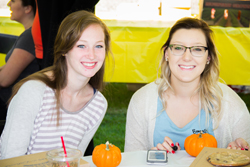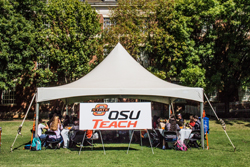OSUTeach program marking successful debut year
Wednesday, December 2, 2015
OSUTeach, Oklahoma State University’s new program aimed at increasing the ranks of mathematics and science educators in the state and beyond, is celebrating early success as it prepares for its second year on the Stillwater campus.
In February 2014, the university was selected as a new UTeach site and awarded a $1.45 million grant, made possible by the Howard Hughes Medical Insti- tute. The first and only UTeach site in Oklahoma and one of just 44 in the U.S., OSUTeach offi- cially launched in the fall of 2014, with the goal of attracting bright mathematics and science students into the teaching profession.
A true collaboration between OSU’s colleges of Education and Arts and Sciences, OSUTeach offers degrees in biological science, chemistry, geology (choice of earth/space science or physical science), mathematics and physics. Students in the program will receive a degree in a STEM major and full teaching certification at the secondary level without added time or cost.
Core elements of the UTeach program include recruitment and retention incentives, a compact degree program, a strong focus on research-based strategies for teaching and learning mathematics and science, intensive field teaching experience and personal guidance from master teachers and faculty members.
Co-directors Steve Marks (College of Education) and Kristen Baum (College of Arts and Sciences), supportive faculty members from both colleges, two new master teachers, John Weaver (mathematics) and Amy Olson (science), and project coordinator Caitlin Barnes comprise the OSUTeach team.
First OSUTeach Students
OSUTeach first welcomed students in the fall of 2014. One of the unique elements of the program is that students gain experience in K-12 classrooms in their very first semester of the program.
The Step 1 and Step 2 classes serve as a start to the degree and offer students the opportunity to check out teaching, to find out if they would like to pursue it as a career, and to receive an incentive stipend. During the 2014-15 school year, 29 students went through Step 1, and 13 completed Step 2. Each received $125 for successfully completing each class.

“I think one of the greatest things about this program is that students get to experience teaching right away,” Olson says. “It helps them make informed decisions about their future and see that as an educator they can have a greater impact on the world.”
The program projects similar enrollment in Step 1 and Step 2 classes this fall, as nearly 40 students have a declared major in one of the program’s five areas of study.
OSUTeach has partnered with Stillwater Public Schools for early field experiences. Mentor teachers from the district host university students in their class- rooms and work with Weaver and Olson.
“We appreciate Stillwater Public Schools’ support,” Marks says. “Classroom teachers are so important to the project. They are investing in future teachers.”
Before students graduate, they will have accumulated 600 hours of field experience. Oklahoma native and OSUTeach mathematics major Danielle Cain, from Broken Arrow, has enjoyed her early classroom experiences.
“I have always wanted to teach and when deciding which college to attend, OSUTeach stuck out to me as the perfect degree plan. Not many fresh- men in college can say they have experience teaching in a classroom,” says Cain, who taught third-graders during the fall and seventh-graders in the spring. “I had always had my mind set on high school education, but through OSUTeach, I have expanded my interest to middle school students as well.”
Norman, Okla., native Laurianne Fisher began her OSU career with the intention of pursuing a degree in chemistry and then pharmacy school. Teaching was a fallback plan.
“I realized that teaching should be my first choice. I joined OSUTeach because I can take all of the advanced chemistry classes while also taking classes that will allow me to graduate with my teaching certification,” Fisher says.
Though she now plans to become a high school chemistry teacher, she found value in working in an elementary classroom.
“(By spending time in an elementary classroom,) I learned some things about my style of teaching that I may not have learned teaching only in a high school classroom,” Fisher says.
Private Support
OSUTeach has been met with interest and enthusiasm from the private sector with several corporations and foundations stepping up to invest in the program and its mission.
Being selected as a UTeach replication site required that OSU raise $1 million in matching funds. Thanks to generous community support and university commitment, OSU has met this challenge. The program has received support from AT&T, Boeing, Inasmuch Foundation, Kerr Foundation Inc., Northrop Grumman Corp., Sarkeys Foundation, Charles & Lynn Schusterman Family Foundation and Williams Co. This funding, along with the initial replication grant, will sustain the program for the first five years.
Eleven students with a declared OSUTeach major have been awarded scholarships supported with funds from AT&T. OSU also received a $1.1 million grant from the National Science Foundation that allows OSUTeach to give Mathematics and Science Robert Noyce Scholarships for upperclassmen and support internship opportunities for students who are freshmen and sophomores.
OSUTeach and the OSU Foundation have been so successful in attracting support that the UTeach Institute requested that the OSU Foundation share keys to success with other replication sites at the annual UTeach Conference. Current fundraising efforts are being focused around endowment fundraising to sustain the program into perpetuity.
Student Engagement
“As we prepared to launch OSUTeach, it was a bit daunting because there was so much to do,” Baum says.
As the program heads into its second full year, it has a newly renovated home at 114 Life Sciences East, faculty members are collaborating to provide an excellent educational experience and students are taking on responsibilities as program ambassadors.

In addition to office space for staff and a meeting area, the new OSUTeach headquarters has a mock classroom with a lab table, a Smart monitor and educational resources so that OSUTeach students have a place to develop and practice lessons that they will implement in the public schools.
A student-led OSUTeach group is in the works. Faculty members took a group of students to the National Science Teachers Association conference this year, and a pair of students attended the UTeach conference this summer. Six students are ambassadors, volunteering 15 hours each semester to represent OSUTeach in outreach efforts.
Thanks to funding from OSUTeach and the Noyce grant, students had the opportunity to participate in paid summer internships to gain experience designing curriculum, tutoring and assisting with camps. Sites included the Oklahoma City Zoo, the Tulsa Zoo, the Oklahoma Aquarium, public schools, Fab Lab (a design and fabrication company) and more.
“A hallmark of the program is the individualized attention students are getting through these kinds of opportunities,” Barnes says. “We’re hearing high praise from students.”
As the excitement and energy surrounding OSUTeach continues to build, the beneficiaries will be the students of these future teachers in Oklahoma schools. Ultimately, the impact of a strong educational base in science and mathematics from educators prepared through OSUTeach should have far-reaching results.
